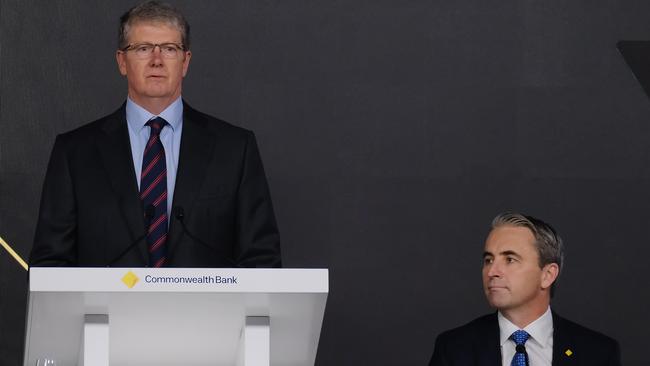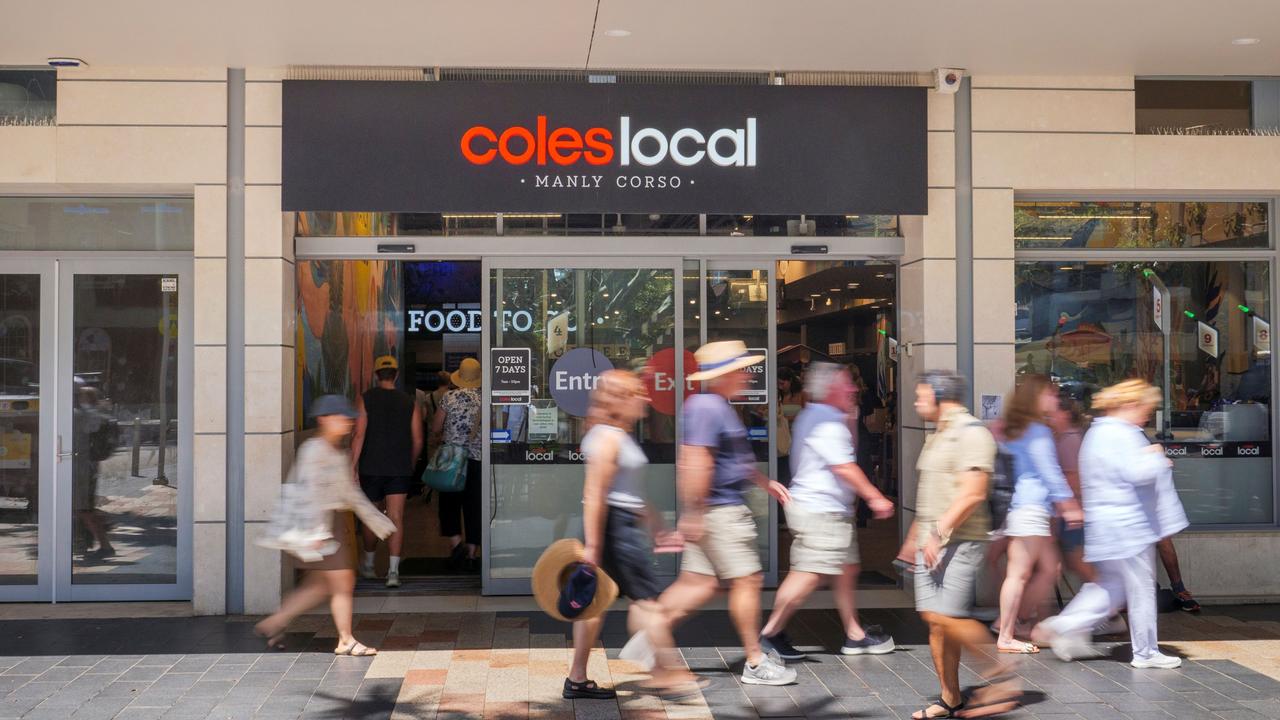CBA warns households feeling the strain after record $5.2bn profit
Commonwealth Bank chief Matt Comyn says households are drawing down savings buffers and will rein in spending to navigate sharp living cost and rate hike pressures.

Business
Don't miss out on the headlines from Business. Followed categories will be added to My News.
Commonwealth Bank chief Matt Comyn says households are drawing down savings buffers and will rein in spending to navigate sharp living cost and rate hike pressures, with borrowers bracing for a similar dose of rates pain over the next 12 months.
While Mr Comyn said he was optimistic about a soft landing for the Australian economy, he noted some households were already feeling “significant strain” from rising interest rates, alongside higher prices across electricity, groceries and other household items.
His comments came as CBA delivered a record $5.15bn interim cash profit, helped by rate rises and growth in business and home lending. But investors fretted about the bank’s earnings prospects and the fact the peak benefit from rate hikes may have passed, sending the stock tumbling 5.7 per cent lower to $103 on Wednesday. That marked the biggest one-day drop since November 2021.
Mr Comyn told The Australian many customers would confront a challenging period in 2023 as rate hikes and house price declines continued, leading to more loan losses.
“It’s somewhat circular in the context of the higher rates go the more pressure that will put on asset prices including housing,” he said.
“We actually anticipate we’re going to increasingly see a flow through in terms of (higher rates on) consumption into other parts of the economy, but I think it will be gradual.
“As we continue to engage with customers we also see behaviours changing … We would expect that they would reduce expenditure outside of their everyday essentials.”
Mr Comyn highlighted that borrowers were feeling about 50 per cent of the impact of the 3.25 percentage points in rate hikes so far since May, due to the mix between standard variable and fixed rate mortgages and a delay in the transmission of the increases.
“There’s another 50 per cent to come,” he added. “By July that number will be 75 per cent and if you assume a cash rate of 3.85 per cent – let’s say the last change in the cash rate is in April – then it will take several months for that to come through … probably by the end of the calendar year it will be about 80 or 85 per cent of the full effect.”
CBA has some $96bn of fixed-rate home loans converting to markedly higher variable rates during 2023.

Mr Comyn cautioned borrowers on lower incomes would bear “the brunt” of higher interest rates and prices across the economy.
“We’ve seen the household savings ratio fall to 7 per cent from a Covid peak of over 23 per cent and house prices have fallen 9 per cent from their peak,” he said.
“We can see savings buffers being drawn down particularly for customers at higher risk from rising cash rates, and there is more impact to come given the changes in the cash rate take time to work through.”
Mr Comyn noted CBA was seeing “extreme change and intense competition” in the mortgage market, as banks fight hard to win customers and those refinancing, often with cashback deals that were growing in size and prevalence.
“We are participating in a market which is atypical to the one that we’ve seen over just about every period I can think of in the last 20 years,” he said, noting some of the activity represented players writing loans below the cost of capital.
On the issue of declining borrowing capacity and the prudential regulator’s settings that see banks put a 3 per cent buffer into loan affordability checks, Mr Comyn said those parameters may need to be reassessed this year.
“As we get towards the top of the rate hiking cycle, we’ve seen a reduction in borrowing capacity, it might be appropriate then to revisit that,” he added. “But we’re not uncomfortable with the settings.”
Mr Comyn said given inflation levels, he understood the Reserve Bank’s rationale for continuing its rate tightening.
“It’s well established that if inflation is allowed to persist at a higher level for longer it is harder to unwind.”
CBA’s $5.15bn first-half cash profit result was up from $4.75bn in the same period a year earlier, and marked a record interim result.
Bloomberg estimates had pointed to CBA reporting a slightly higher interim profit of $5.17bn. The bank’s result was curtailed by rising expenses and a $586m increase in the loan impairment expense.

CBA’s net interest margin – a profitability measure that gauges what a bank earns on loans less funding costs on deposits – jumped to 2.10 per cent, up 23 basis points on the prior six-month period. Operating income swelled 12 per cent in the first-half, versus the year earlier period, as net interest income climbed.
That was helped by an aggressive RBA rate tightening cycle and loan growth across business and home lending. But CBA said the benefit from rate rises would be somewhat eroded by factors including competition for home loans and deposits and increased customer switching, triggering investor concerns.
“CBA is still likely to post strong full-year results in 2023, but the outlook for growth beyond this year becomes one of flat-to-down with net interest margins no longer a tailwind and bad debts likely to rise,” said Matthew Davison, a Martin Currie Australia portfolio manager.
“How much may depend on CBA’s soft-landing scenario, but it’s worth noting the group still has balance sheet momentum and the ability to flex costs in support of earnings. The stock valuation probably demands more, however.”
Barrenjoey analyst Jon Mott said CBA’s commentary around margins suggested “more headwinds than tailwinds” and he highlighted a chart that showed CBA’s margins peaking in October last year.
“If the margin has peaked, this would likely imply downgrades to consensus and Barrenjoey (earnings) estimates.”
CBA’s funding is 75 per cent drawn from household and business deposits.
The bank’s results also came as S&P Global Ratings said Australian prime and nonconforming home-loan arrears rose in December.
CBA’s troublesome and impaired assets as a percentage of its total exposures eased by 2 basis points to 0.46 per cent from the prior six months. But the decline masked a notable increase in troublesome and impaired assets in sectors, including construction and commercial property.
CBA declared a better than anticipated first-half dividend of $2.10 per share, up from the $1.75 interim payment last year.
The bank’s strong capital position allowed it to extend its share buyback by $1bn. CBA has showered investors with capital returns since 2021 and Wednesday's announcement will take the total capital returned to about $9bn, not including dividend payments.
CBA’s common equity tier one capital ratio was 11.4 per cent in the first half. Under new capital requirements, effective in January, the bank said its proforma capital ratio was 12.1 per cent, well above the regulatory minimum.
Mr Comyn said the bank’s balance sheet would help it traverse economic headwinds but he noted CBA expected business credit growth to slow alongside a tempering global economy this year. CBA’s retail and business banking divisions and its New Zealand arm reported higher interim earnings, while the institutional and markets unit posted a decline.
The RBA has raised rates to 3.35 per cent since May last year, the highest level in more than a decade. Bank margins have benefited as they passed on successive rate increases in their entirety to borrowers, but held back some of the hikes from savers as wholesale funding costs rose.
CBA’s rival ANZ last week provided a December quarter update showing robust credit growth and a decline in impaired assets, despite the sharp increase in interest rates through that period. National Australia Bank and Westpac provide quarterly updates to investors on Thursday and Friday, respectively.
Originally published as CBA warns households feeling the strain after record $5.2bn profit





